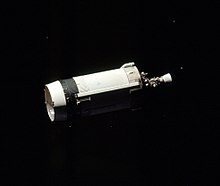J002E3


J002E3 is the name given to a putative asteroid discovered in September 2002 . Further investigations showed that the spectral properties of the surface of the object are similar to white color and that it is probably the third stage (S-IVB) of the Saturn V rocket (serial number S-IVB-507) used in the Apollo 12 mission acts.
discovery
On September 3, 2002, the astronomer William Kwong Yu Yeung (Bill Yeung) discovered an asteroid , which he gave the temporary name J002E3 . What was unusual about this object was that it appeared to be in orbit around the earth. This surprised astronomers because the moon is the only large object orbiting the earth with the exception of the Kordylewsk clouds , the existence of which was still controversial at the time. Other celestial bodies cannot stay in earth orbit because of the gravitational interactions between earth, sun and moon. Therefore, J002E3 must have entered Earth orbit recently, but there was no recently launched spacecraft that matched the object's orbit. One possible explanation would have been that it could have been a rock about 30 m in diameter. Spectral analyzes by a team at the University of Arizona led by astronomers Carl Hergenrother and Robert Whiteley revealed that the spectrum of the object matched that of titanium dioxide . This compound was part of the white paint with which the third stage of the Saturn V rocket was painted to protect it from heating up by the sun. Tracing the orbit showed that the object had orbited the sun for 31 years and was last near the earth in 1971. This date suggested that it might be part of the Apollo 14 mission , but NASA was able to prove the whereabouts of all of the hardware on that mission. For example, the third stage of Apollo 14 had been allowed to hit the moon in a controlled manner for seismic investigations. The most likely explanation was that it was the S-IVB stage of Apollo 12. NASA wanted to bring the third stage after the separation of the Apollo spacecraft into an orbit around the sun, but the ignition of the auxiliary engines ("ullage motors") took too long after the separation, so that there was not enough fuel left to power the S. -IVB to give the necessary escape speed to leave the earth-moon system. Instead, it fell into a semi-stable orbit around the Earth and Moon after passing the moon on November 18, 1969. Due to a series of gravitational disturbances, it entered solar orbit in 1971 and reappeared in the Earth-Moon system 31 years later. J002E3 left Earth orbit in June 2003 and will return in around 2032.
Possible re-entry into the earth's atmosphere
The empty S-IVB stage has a mass of 9559 kg and is in an unstable orbit, which could possibly lead to a collision with Earth. However, this would not necessarily be a problem, since objects of this mass enter the earth's atmosphere about 10 times a year.
A collision with the moon would also be possible.
See also
- 6Q0B44E , space junk thought to be a meteoroid
- 2006 RH 120 , meteoroid thought to be space debris
- 2007 VN 84 , name for an alleged asteroid that turned out to be the Rosetta probe
- (3753) Cruithne
- WT1190F
Web links
- Leftover Apollo Rocket Stage
- Animations of the orbit of J002E3
- Animations of the complete Earth encounter of J002E3
- CCD Image of J002E3
Individual evidence
- ↑ a b c J002E3: To Update , NASA . October 9, 2002. Retrieved September 18, 2013.
- ↑ a b K. Jorgensen, A. Rivkin, R. Binzel, R. Whitely, C. Hergenrother, P. Chodas, S. Chesley, F. Vilas: Observations of J002E3: Possible Discovery of an Apollo Rocket Body . In: Bulletin of the American Astronomical Society . 35, May 2003, p. 981. bibcode : 2003DPS .... 35.3602J .
- ↑ Roger E. Bilstein: Chapter 6 . In: Stages to Saturn: A Technological History of the Apollo / Saturn Launch Vehicle . DIANE Publishing, August 1999, ISBN 978-0-7881-8186-3 .
- ^ Philip Bland: The impact rate on Earth . In: Royal Society of London Series A Philosophical Transactions . 363, No. 1837, December 2005, pp. 2793-2810. bibcode : 2005RSPTA.363.2793B . doi : 10.1098 / rsta.2005.1674 .
- ↑ Philip A Bland, Natalya A. Artemieva: The rate of small impacts on Earth . In: Meteoritics . 41, No. 4, April 2006, pp. 607-631. bibcode : 2006M & PS ... 41..607B . doi : 10.1111 / j.1945-5100.2006.tb00485.x .
